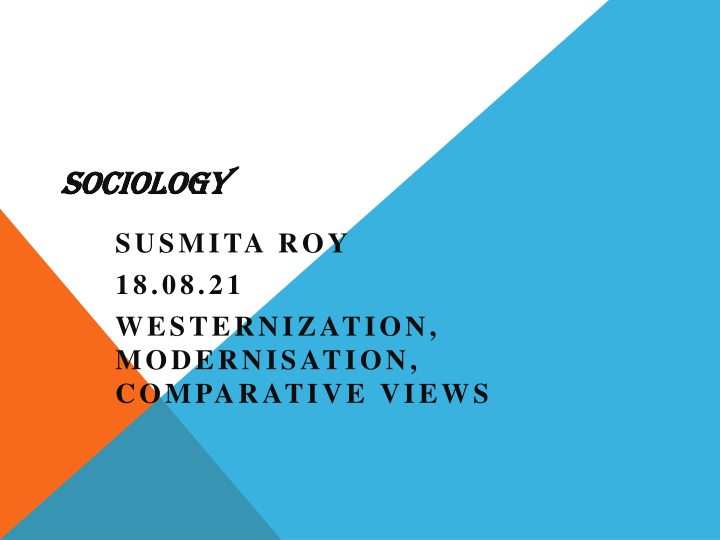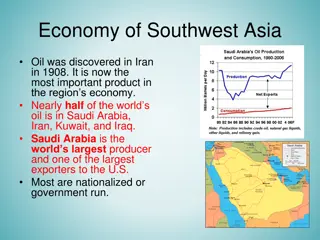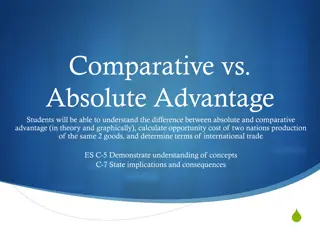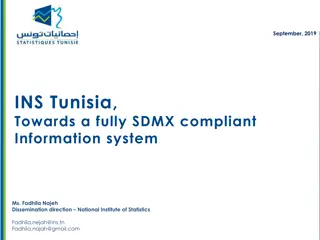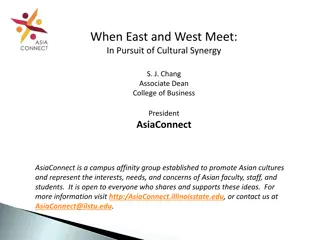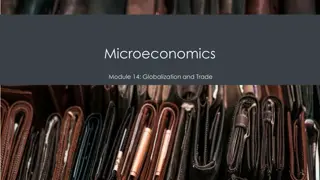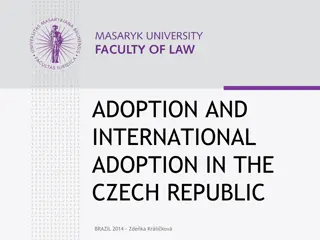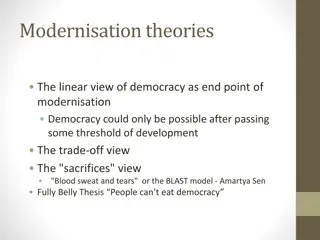Westernization and Modernization: Comparative Views on Cultural Adoption
Westernization is the adoption of Western European practices and culture by societies worldwide, driven by colonization and globalization. It involves the imposition of Western norms, education systems, and values, leading to both acceptance and resistance. Key features include humanitarianism, equalitarianism, secularization, initiation of social reforms, and a focus on science and technology. The process has impacted various countries, influencing their social, economic, and political structures.
Download Presentation

Please find below an Image/Link to download the presentation.
The content on the website is provided AS IS for your information and personal use only. It may not be sold, licensed, or shared on other websites without obtaining consent from the author.If you encounter any issues during the download, it is possible that the publisher has removed the file from their server.
You are allowed to download the files provided on this website for personal or commercial use, subject to the condition that they are used lawfully. All files are the property of their respective owners.
The content on the website is provided AS IS for your information and personal use only. It may not be sold, licensed, or shared on other websites without obtaining consent from the author.
E N D
Presentation Transcript
SOCIOLOGY SOCIOLOGY SUSMITA ROY 18.08.21 WESTERNIZATION, MODERNISATION, COMPARATIVE VIEWS
Westernization, the adoption of the practices and culture of western Europe by societies and countries in other parts of the world, whether through compulsion or influence. Westernization reached much of the world as part of the process of colonialism and continues to be a significant cultural phenomenon as a result of globalization. Westernization began with traders, colonizers, and missionaries from western Europe who believed that their way of life was superior to those of the peoples in the countries to which they traveled. The occupied peoples were required or encouraged to adopt western European business practices, languages, alphabets, and attire. They were also encouraged to assume western European education systems, literary and artistic standards, and to convert to Christianity. Many countries had Western types of government and military practices imposed on them. In the 20th century the United States, itself the result of western European colonization of North America, arguably became the most significant exporter of Western culture. Its movies, popular music, and popular fashion were taken up not only in Asia, Africa, and Central and South America but even in western Europe itself. Technology acted as both a form of and a transmitter of Westernization. Some leaders, including Kemal Atat rk of Turkey and Reza Shah Pahlavi of Iran, embraced Westernization, but the tendency of Westernization to obliterate languages and cultural forms of other peoples also aroused widespread opposition.
features of westernization Some of the important characteristics of westernisation included by Srinivas are discussed below: Humanitarianism: Westernisation is loaded with certain value preferences. ... Equalitarianism: ... Secularisation: ... Initiation of social reforms: ... Predominance of science and technology:
Humanitarianism: Westernisation is loaded with sure worth preferences. A most important worth, that successively subsumes many alternative values, is what could also be loosely characterised as philosophy, by that is supposed a full of life concern for the welfare of all folks, no matter caste, economic position, religion, age and sex. Equalitarianism: Westernisation has another worth of school of thought. it's a democratic worth and stands for minimising difference, removal of impoverishment and liberty to all or any. Secularization: Both country rule and at a later stage the Constitution of Asian nation introduced a brand new worth of secularisation. Initiation of social reforms: The idea of assimilation that was propagated by country rule affected arduous on social evils that worn the Indian society.
Predominance of science and technology: The British rule conjointly introduced science and technology in Indian society. This brought railways, steam engines and technology. characteristics of westernization include: 1. Avoidance of uncertainty, 2. Inclusion of new economic and political rules and policies, 3. A greater emphasis on the models of rationalism and humanitarian doctrines, values and understanding the souls, 4. Increased rate of westernization might also boost the process of Sanskritization in many cases.
Westernization inevitably undermines full development of indigenous cultures and traditions of non-Western people. Furthermore, it creates resentment among non-Western people toward Western values and, fosters racism and prejudice against non-Western people in Western societies.
Modernization theory Modernization theory is used to explain the process of modernization within societies. Modernization refers to a model of a progressive transition from a 'pre-modern' or 'traditional to a 'modern' society. Modernization theory originated from the ideas of German sociologist Max Weber (1864 1920), which provided the basis for the modernization paradigm developed by Harvard sociologist Talcott Parsons (1902 1979). The theory looks at the internal factors of a country while assuming that with assistance, "traditional" countries can be brought to development in the same manner more developed countries have been. Modernization theory was a dominant paradigm in the social sciences in the 1950s and 1960s, then went into a deep eclipse. It made a comeback after 1991 but remains a controversial model.
Modernization theory suggests that traditional societies will develop as they adopt more modern practices. Proponents of modernization theory claim that modern states are wealthier and more powerful and that their citizens are freer to enjoy a higher standard of living. Developments such as new data technology and the need to update traditional methods in transport, communication and production make modernization necessary or at least preferable to the status quo. That view makes critique difficult since it implies that such developments control the limits of human interaction, not vice versa. And yet, seemingly paradoxically, it also implies that human agency controls the speed and severity of modernization. Supposedly, instead of being dominated by tradition, societies undergoing the process of modernization typically arrive at forms of governance dictated by abstract principles. Traditional religious beliefs and cultural traits, according to the theory, usually become less important as modernization takes hold.
Modernization and globalization Globalization can be defined as the integration of economic, political and social cultures. It is argued that globalization is related to the spreading of modernization across borders. Global trade has grown continuously since the European discovery of new continents in the Early modern period; it increased particularly as a result of the Industrial Revolution and the mid-20th century adoption of the shipping container. Annual trans-border tourist arrivals rose to 456 million by 1990 and almost tripled since, reaching a total of over 1.2 billion in 2016. Communication is another major area that has grown due to modernization. Communication industries have enabled capitalism to spread throughout the world. Telephony, television broadcasts, news services and online service providers have played a crucial part in globalization. Former U.S president Lyndon B. Johnson was a supporter of the modernization theory and believed that television had potential to provide educational tools in development
modernization, in sociology, the transformation from a traditional, rural, agrarian society to a secular, urban, industrial society. Modern society is industrial society. To modernize a society is, first of all, to industrialize it. Historically, the rise of modern society has been inextricably linked with the emergence of industrial society. All the features that are associated with modernity can be shown to be related to the set of changes that, some 250 years ago, brought into being the industrial type of society. This suggests that the terms industrialism and industrial society imply far more than the economic and technological components that make up their core. Industrialism is a way of life that encompasses profound economic, social, political, and cultural the comprehensive transformation of industrialization that societies become modern. changes. It is by undergoing
Modernization is a continuous and open-ended process. Historically, the span of time over which it has occurred must be measured in centuries, although there are examples of accelerated modernization. In either case, modernization is not a once-and-for-all-time achievement. There seems to be a dynamic principle built into the very fabric of modern societies that does not allow them to settle, or to achieve equilibrium. Their development is always irregular and uneven. Whatever the level of development, there are always backward regions and peripheral groups. This is a persistent source of strain and conflict in modern societies. Such a condition is not confined to the internal development of individual states. It can be seen on a global scale, as modernization extends outward from its original Western base to take in the whole world. The existence of unevenly and unequally developed nations introduces a fundamental element of instability into the world system of states.
Modernization seems to have two main phases. Up to a certain point in its course, it carries the institutions and values of society along with it, in what is generally regarded as a progressive, upward movement. Initial resistance to modernization may be sharp and prolonged, but it is generally doomed to failure. Beyond some point, however, modernization begins to breed discontent on an increasing scale. This is due in part to rising expectations provoked by the early successes and dynamism of modern society. Groups tend to make escalating demands on the community, and these demands become increasingly difficult to meet. More seriously, modernization on an intensified level and on a world scale brings new social and material strains that may threaten the very growth and expansion on which modern society is founded. In this second phase, modern societies find themselves faced with an array of new problems whose solutions often seem beyond the competence of the traditional nation-state. At the same time, the world remains dominated by a system of just such sovereign nation-states of unequal strengths and conflicting interests.
Modernization seems to have two main phases. Up to a certain point in its course, it carries the institutions and values of society along with it, in what is generally regarded as a progressive, upward movement. Initial resistance to modernization may be sharp and prolonged, but it is generally doomed to failure. Beyond some point, however, modernization begins to breed discontent on an increasing scale. This is due in part to rising expectations provoked by the early successes and dynamism of modern society. Groups tend to make escalating demands on the community, and these demands become increasingly difficult to meet. More seriously, modernization on an intensified level and on a world scale brings new social and material strains that may threaten the very growth and expansion on which modern society is founded. In this second phase, modern societies find themselves faced with an array of new problems whose solutions often seem beyond the competence of the traditional nation- state. At the same time, the world remains dominated by a system of just such sovereign nation-states of unequal strengths and conflicting interests.
Yet challenge and response are the essence of modern society. In considering its nature and development, what stands out initially at least is not so much the difficulties and dangers as the extraordinary success with which modern society has mastered the most profound and far-reaching revolution in human history. This article discusses the processes of modernization and industrialization from a very general and primarily sociological point of view. It does so also, it should be remembered, from a position within the very processes it describes. The phenomena of industrialization and modernization that are taken to have begun more than two centuries ago and that were not until much later identified as distinct and novel concepts have not yet arrived at any recognizable closure. The end of the story, if there is one, is thus not in sight, and the question of an ultimate judgment on the nature and value of this vast historical movement is unanswerable.
The revolution of modernity If one imagines all of human social evolution charted on a 12-hour clock, then the modern industrial epoch represents the last five minutes, no more. For more than half a million years, small bands of what we may agree were human beings roamed the earth as hunters and gatherers. With simple stone tools and a social order based on kinship ties, they successfully preserved the human species against predators and natural calamities.
The nature of modern society General features Modernity must be understood, in part at least, against the background of what went before. Industrial society emerged only patchily and unevenly out of agrarian society, a system that had endured for 5,000 years. Industrial structures thus took much of their characteristic form and colour from the rejection, conscious or unconscious, of preindustrial ways. Industrialism certainly contained much that was new, but it remained always at least partly an idea that in both its theory and its practice was to be understood as much by what it denied as by what it affirmed. The force of the modern has always been partly a reactive force, a force that derived meaning and momentum by a comparison or contrast with, and by rejection or negation of, what went before. Considered at the most general level, this point suggests a view of modernization as a process of individualization, differentiation or specialization, and abstraction. Put more concretely: first, the structures of modern society take as their basic unit the individual rather than, as with agrarian or peasant society, the group or community. Second, modern institutions are assigned the performance of specific, specialized tasks in a social system with a highly developed and complex division of labour; in this they stand in the sharpest possible contrast with, for instance, the family in peasant society, which is at once the unit of production, and authoritative decision-making. consumption, socialization,
Economic change Economic historians and theorists have been inclined to stress economic growth as the central defining feature of an industrial as opposed to a nonindustrial economy. Thus, the British historian Edward Anthony Wrigley declared that industrialization is said to occur in a given country when real incomes per head begin to rise steadily and without apparent limit. The American economic historian W.W. Rostow popularized a similar conception in suggesting that with industrialization, the economy at a certain point takesoff into self-sustained growth ; all the relevant statistical indexes of the economy investment, output, growth rate, and so on take sudden, sharp, almost vertical upward turns. Underlying this phenomenon of growth are certain core components of the industrial system. These include technological change, whereby work is increasingly done by machines rather than by hand; the supplementing or replacement of human and animal power by inanimate sources of energy, such as coal and oil; the freeing of the labourer from feudal and customary ties and obligations and the consequent creation of a free market in labour; the concentration of workers in single, comprehensive enterprises (the factory system); and a pivotal role for a specific social type, the entrepreneur.
The vast increase in agricultural productivity on which this sectoral change in employment depends is characteristic of industrialism. Industrial society breaks through the historic limits of scarcity. In the past, the potential for economic growth was always cut short by Malthusian checks on population, by limitations of food supply, or by the shortage of easily available raw materials such as wood. Population change There have been two major population explosions in the course of human social evolution. By the end of the Paleolithic Period the world s human population is estimated to have been between five and six million (an average of 0.1 person per square mile [0.04 person per square kilometre] of Earth s land area). Following the Neolithic or agricultural revolution, the population made its first major leap, reaching over the short span of 8,000 years around 150 million by the year 1000 BCE (2.6 persons per square mile). For the next two and a half thousand years there was relatively little change. It was in western Europe, with the Industrial Revolution, that the second population revolution began. Europe s population doubled during the 18th century, from roughly 100 million to almost 200 million, and doubled again during the 19th century, to about 400 million. It was in Europe, too, that the pattern first emerged that has come to be known as the demographictransition (see population: Theory of the demographic transition).
The populations of nonindustrial countries are normally stable (and low) because high birth rates are matched by high death rates. With industrialization, improvements in medical knowledge and public health, together with a more regular food supply, bring about a drastic reduction in the death rate but no corresponding decline in the birth rate. The result is a population explosion, as experienced in 19th-century Europe. In time, however, as European societies showed in the early 20th century, the urbanized populations of industrial societies voluntarily lower their birth rates and population growth flattens out. Work and the family In preindustrial or nonindustrial society the family is the basic unit of production. All its members engage in a cooperative set of subsistence activities. In a typical example from early 18th-century England, the man might be a weaver and his wife a spinner, with the younger children acting as assistants in the joint domestic enterprise. Mixed in with this wage or piece labour would probably be the cultivation of a small plot of land, together with access to common land to forage for fuel and to hunt small game. Industrialization radically disrupts this more or less autonomous family economy. It takes away the economic function of the family, of consumption and socialization. Production moves away from the household to the factory. The commons are enclosed, and the land commercially exploited for national and international markets. Some individuals become the owners and the managers of the new system. and reduces it to a unit
Social structure Given the importance of economic institutions in general, and of employment in particular, it is not surprising to find that industrial society tends to produce a new principle in the ordering and ranking of individuals. Economic position and relationships become the key to social position and class membership. This is new, at least in its extent. While wealth or the lack of it were always important in determining social position, they were not usually the sole or even the central determinant. In all nonindustrial societies, attributes of tribal membership, race, religion, age, and gender are of equal and often greater importance in assigning individuals to a position in the social hierarchy. In the traditional Indian caste system, for instance, the religious eminence of even the poorest Brahman marks him out as a member of the highest and most esteemed caste. One reason why Marx s prediction has not come to pass in any developed society is that, though perhaps dominant in the long run, economic relationships have not so sweepingly eliminated other noneconomic considerations. Older sources of identity continued to exert considerable power. Groups based on ethnic, religious, and regional ties overlapped with and occasionally submerged those based solely on the tie of economic interest.
Secularization and rationalization At the most abstract level of analysis, modernization leads to what Max Weber called the disenchantment of the world. It calls into question all the superhuman and supernatural forces, the gods and spirits, with which nonindustrial cultures populate the universe and to which they attribute responsibility for the phenomena of the natural and social worlds. At any rate, once invented in Europe, especially Protestant Europe, secularization was carried as part of the package of industrialism that was exported to the non-European world. Wherever modern European cultures have impinged, they have diffused secularizing currents into traditional religions and nonrational ideologies. Although secularization is a general tendency or principle of development in modern societies, this does not imply that religion is driven out altogether from society.
REFERENCES C.N.RAO GOOGLE SCHOLAR
